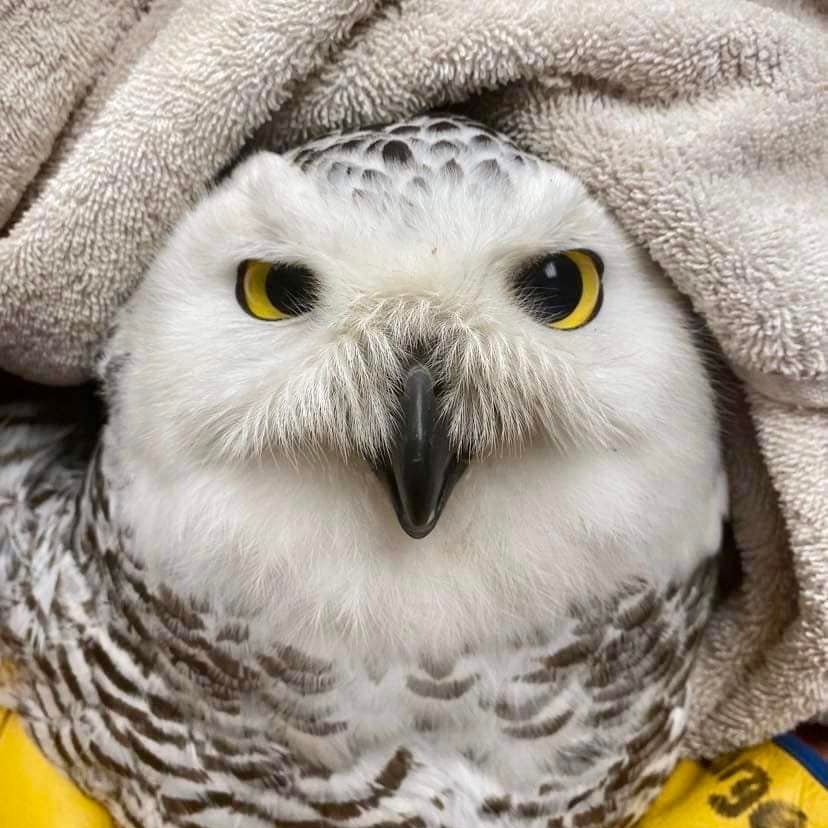
18th of Owltober!
A Snowy Owl had a bad case of rodenticide poisoning (evidenced by a low blood count from a small wound that wouldn’t clot). DuPage Wildlife aided her recovery with Vitamin K treatment and expert care.
Original post – 03 Feb 2022
by DuPage Wildlife Conservation Center
located in Glen Ellyn, Illinois
Website | Instagram | Facebook
Original text:
At this point, we feel like a broken record, but we can’t emphasize enough that anticoagulant rodenticides are extremely harmful to our wildlife populations, especially raptors.
This week’s Patient of the Week is an arctic visitor that many have been able to see in the wild this winter – a snowy owl! This individual, likely a female from her plumage (though juvenile males look very similar), was brought in on Jan. 31. Volunteers with the Chicago Bird Collision Monitors (CBCM) collected this individual after she was found down with a large amount of blood on her feet and legs. On presentation, she was very quiet for her species (they LOVE to bite), had a significant amount of blood on both her legs and feet from just a small wound, and her mucous membranes were extremely pale.
Does this sound similar to some of our other recent patients of the week? It should. When we checked her bloodwork, her red blood cell level was only 15% (it should be 40-50%) and her blood didn’t start to clot until 30 minutes after collection (it should take 2-5 minutes). Her body was in decent condition, and her only injury on exam was a small wound on her left foot. Sadly, these findings all point to this individual suffering from anticoagulant rodenticide poisoning.
With her red blood cell count so low, we were concerned that she might require a blood transfusion. Since we don’t have another snowy owl in our care, we likely would have used blood from a great horned owl to be as similar as possible (although avian transfusions can use blood from almost any other avian species). Thankfully, with supportive care and vitamin K therapy, this bird is already showing great strides in improvement and is eating on her own. In the next few days, as long as she continues to improve, she will be anesthetized for X-rays and her wound will be assessed to determine if it needs surgical closure.
In recent years, we have seen numerous irruptions of this species. An irruption is when a large population of a certain species migrates outside their normal range following a highly successful breeding period. For snowy owls, this is linked to a boom in the lemming populations in the north, which is their favored prey. As you can imagine, the difference in landscape between the tundra they are used to and more urban areas is quite extreme, causing some of these birds to end up in trouble — like vehicle collisions, power line electrocutions, and in this case, consumption of poisoned prey. In big irruption years, snowy owls have been spotted as far south as Florida!
Snowies are built for the cold with excellent camouflage and an incredibly thick layer of feathers. Owls already generally have feathery feet, but snowy owls have built in snow boots with heavy feathering down the legs and feet, even in between their toes. Snowy owls tend to be more active during the day and are often seen roosting on the ground or other flat surfaces (sometimes rooftops) since that’s normal for them — there aren’t too many trees in the arctic. They also have feather tufts like the horned owls, but they are short and well-hidden on their thickly feathered, rounded heads.
With a snow day like today, we can only hope to get this beautiful owl back out in the wild and the world it is so well adapted for
Link to donate to DuPage Wildlife Conservation Center for those willing and able.
xo owlsintowels
💛🦉
| Species | Common Name | More info |
|---|---|---|
| Bubo scandiacus | Snowy Owl | Wiki link |

